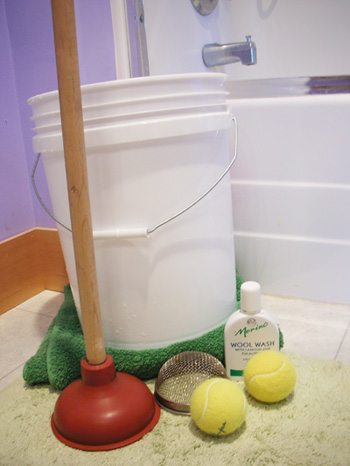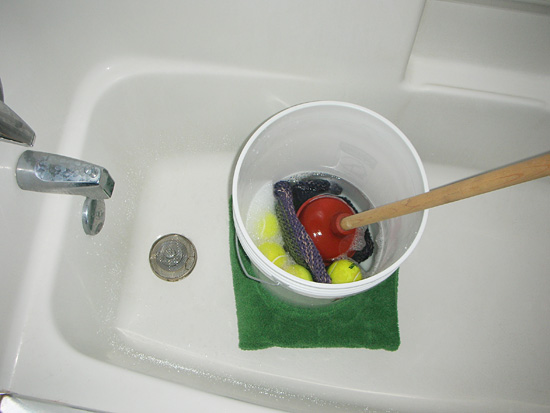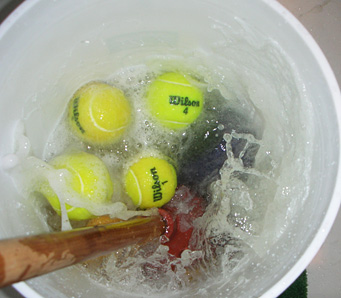As knitters
we spend a lot of time creating garments and
items from the sheep up, without the help of
machines. It seems contrary
then, that when felting something the preferred
method is to give up our items to a machine
and hope for the best. I also find it
interesting that there is almost a complete
lack of writing on different methods of felting. Am
I the only knitter who wants to felt but has
a new fangled energy efficient front loading
washer that won’t do what I want? Or
the only knitter who lives in an apartment
without a machine of my own that can’t
afford to use a Laundromat to felt my knitting? How
did they felt back in the day? Felting
has much longer than the advent of the top
loading washer, we’ve just forgotten
the old methods and moved on. It’s
time to get back to where we came from. For
those wondering if felting by hand is really
worth it, I’ve created a pro/con list
to better illustrate why felting by hand is
so wonderful.
Hand-Felting Pros |
Hand-Felting Cons |
- Uses less
water than a machine
|
- You do all
the work of a machine
|
- More control
over your felting
|
|
- Great
workout for your arms (who doesn’t
want well toned arms?)
|
- Potential
drain issues (easily kept under control
with a strainer)
|
|
|
- No guilt
over felting only one small item
|
|
- Can be done
in a limited amount of space with limited
supplies
|
|
  Being
both an avid felter and owner of a front-loading
washing machine, I have developed a method
of felting by hand that I find to be very successful. Now
I am not under any delusion that I have created
a new method, or that my reinvention of the
wheel is an exact replica of how felting would
have occurred in centuries past. The
method detailed here is a modern version of
an ancient technique that doesn’t require
anything but your own two hands and a few select
tools; no batteries or plugs needed. Being
both an avid felter and owner of a front-loading
washing machine, I have developed a method
of felting by hand that I find to be very successful. Now
I am not under any delusion that I have created
a new method, or that my reinvention of the
wheel is an exact replica of how felting would
have occurred in centuries past. The
method detailed here is a modern version of
an ancient technique that doesn’t require
anything but your own two hands and a few select
tools; no batteries or plugs needed.
The first step
is to gather your supplies. These
can all easily be found at your local hardware
store, or more often than not, in the garage.
- Bucket
- Plunger (preferably unused)
- Towel
- Strainer (I use a small circular one pilfered
from my Mother’s kitchen)
- Tennis Balls (optional)
- Soap (whatever you would wash your handknits
in)
Set-up is simple: fold the towel, put your
bucket on top, fill with very hot water and
squirt in a little soap. I do all of this in the shower
as it makes clean up much easier. The
towel is a key element and shouldn’t
be skipped as the bucket bottom may actually
harm your shower. If
you look closely you will find that your shower
or tub is not flat and the bottom of your bucket
is; this can be a problem if you plan on felting
in your shower. The folded towel under
the bucket fills the gap and cushions the bottom
of the shower from the bucket. It also cuts
down on noise.

When filling the bucket,
I use water as hot as it will come out of the
tap. I don’t use boiling water
because when I felt, I splash, and at least
half of those splashes end up in my face. I
also generally only fill the bucket about half
full because I am a vigorous felter -- any
more than half full and the water ends up on
the outside of the bucket anyway. Try
different amounts of water and you’ll
soon find an equilibrium that works for you.
Sometimes I'll add cold water to shock the
fibers -- this helps the felting process.
Now comes the fun part,
the actual felting. This
is your big chance to get up and move around
after sitting so long while you were knitting. This
is also a great opportunity to get out some
aggression; I always feel a little like Laura
Ingalls Wilder at the butter churn when she’s
had a bad day and Alfonso is being a jerkface. The
main thing to remember is that the goal here
is to get fibers to stick together. Gentleness
is not going to get the desired result. I’ve
known knitters to gently swirl their test swatch
in a pot of boiling water to no avail. All
they got was an ever so slightly smaller and
fuzzier version of what they started with. The
three main elements of felting are heat, water
and agitation, and you are providing
the agitation in this scenario.
  I
am generally a violent felter and try to impersonate
a washing machine as much as possible, something
like a butter churn on speed. I
get water all over,
and have a good time while I’m at it. My
mother, on the other hand, is a much more deliberate
felter with almost no splashing. My
method is quicker, more physically tiring,
and produces a lot more lint. My mother’s
method takes a lot longer, isn’t very
tiring and produces almost no lint. The
thing to remember is that felting is not instantaneous,
even in a washing machine. It generally
takes me about the same amount of time to felt
by hand as it would in a machine, except that
you have to do all the work...so it seems
longer. I
am generally a violent felter and try to impersonate
a washing machine as much as possible, something
like a butter churn on speed. I
get water all over,
and have a good time while I’m at it. My
mother, on the other hand, is a much more deliberate
felter with almost no splashing. My
method is quicker, more physically tiring,
and produces a lot more lint. My mother’s
method takes a lot longer, isn’t very
tiring and produces almost no lint. The
thing to remember is that felting is not instantaneous,
even in a washing machine. It generally
takes me about the same amount of time to felt
by hand as it would in a machine, except that
you have to do all the work...so it seems
longer.
I generally throw a few tennis
balls in the mix to trick myself into believing
things will go much faster with them in the
mix. I do this especially if I am only
felting one small item. If I have a bucket
full of knitting, I don’t really feel
it necessary to add the tennis balls; they
actually seem to get in the way instead of
helping.
The main benefit of
felting by hand is that you can keep a closer
eye on your project as it felts. You
are in very little danger of overfelting and
ending up with a hat that fits no human, child
or adult as long as you pay attention. You
are actually in more danger of not felting
quite enough, but this is easily overcome with
sheer knitterly tenacity and perseverance. Don’t
panic when you’ve been churning away
for a few minutes and you anxiously look at
your knitting to see if there has been any
change and it actually seems bigger. This
is normal. The fibers all relax in the hot
water and get bigger before they get smaller. It
will seem like you churn and churn and churn
until the cows have come home and left again
with no change. This
is the felting equivalent of the infamous black
hole in knitting; you knit for ages, miles
of yarn pass through your fingers and you stop
to measure to find that your knitting has somehow
decreased in size. Then you pull out
your felting and all of a sudden the change
is occurring, the fibers are giving up and
giving in. Once you see some felting
happening, things go very quickly. Unless
of course you are trying to felt cotton, in
which case you might want to think about a
different hobby [plant fibers won't felt]. Since
you are not at the mercy of any machine, you
can stop when your felted piece is exactly
the way you want it.
Occasionally you’ll
want to change the water in the bucket. I
generally change after the water has become
tepid and full of lint. As
with a washing machine, you don’t want
all that loose fiber to go down the drain,
unless you enjoy showering while standing ankle
deep in water. Scoop up as
much as you can with your hands and toss it
in the garbage; then I put my little strainer
over the drain and pour the bucket of water
over that. All that fiber is the reason
most books suggest you put your knitting in
a pillow case before felting. However,
if you have time and are super worried about
lint, taking a slower, less violent approach
to the felting process produces almost no lint
to speak of.
After you have achieved
a perfectly felted object, sit back with
a cup of tea and some new knitting and think
about Laura Ingalls and her butter churn. |

